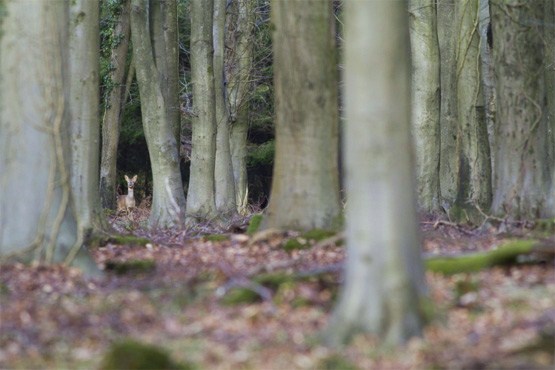Peter Jones takes a closer look at the prospect of managing deer during the month of March.

(Above pic' Roe Doe in Woodland - courtesy of Ewan Dryburgh)
This month before I begin my usual ramble about what you can expect during the month ahead. I’d like to take a moment to draw your attention to a new venture that we are undertaking here at County Deer Stalking.
As well as providing you with useful information about the month to come, our Almanac will now also contain a link to a short film that will document a stalk during the preceding month. These films will be accessible from the Almanac and from the website. Each film will be seasonal and packed with useful hints and tips. To view our first film about Winter Roe Does in February; simply click on the following link: short-films
(If you have not subscribed to the Almanac yet, then please take a moment to do so. In doing so you will insure that the Almanac and accompanying film is sent direct to you by email every month)
Now, onto the month ahead....‘stress’ is the word that is most apt for March. Not stress for us but for the deer. Mortality rates are in fact at their highest amongst deer in the latter part of the winter, available browse in the woods is pitifully low over the winter months, added to which the cold and wet takes its toll on animals that are now increasingly prone to parasites and nutritional deficiency.
In addition to this Does and Hinds are heavily pregnant, ‘glass’ a female at the end of March and you will notice that her sides are swollen and heavy. Indeed laden with the burden of pregnancy, many females will understandably be reluctant to move from their ‘couches’ unless pressed.
For these reasons some deer managers do not stalk during March, but instead choose to use this month as an opportunity to give the deer a rest. Professional managers who adopt this approach instead set about the various chores that mount up over the year, mending high seats, widening woodland rides etc. Whatever your position on stalking late winter does, I would recommend that you pursue already vulnerable animals with a degree of consideration for their condition and plight.
Either way March is traditionally the best month in order to carry out a head count. Establishing the precise number of deer on your ground is an inexact science, however March is traditionally the best time of year to gauge an approximation. The reason for this is twofold, firstly the deer will be more visible with the lack of cover, and secondly with the lack of browse in the woods, the deer are more prepared to break cover and feed openly in the fields, from this position they can of course, be more readily observed.
This is particularly so of Roe Deer, who with their territorial instincts being at an annual low, will be highly tolerant of one another in close proximity, a trait that is soon set to change in the coming weeks ahead.
Personally I love being out in the countryside in March, the days lengthen and the woods begin to awaken. The mid day sun starts to appear higher in the sky and with it comes an increase in warmth. Sensing this slight shift in temperature and daylight hours, the countryside starts to rejuvenate, buds and flowers start to appear and the drone of bees can be heard as they begin to busy themselves. Spring is but a few weeks away and otherwise secretive deer can be seen lying lazily in sunny glades and in woodland margins, as if relishing the prospect of the more pleasant and plentiful months to come.
(For more information about the contentious issue of culling Does in March click on the following link: doe-culling-in-march)
 IN Season in England & Wales: Roe Does, Fallow Does & Fallow Buck, Sika Stags & Sika Hinds, Red Stags & Red Hinds, CWD Bucks & CWD Does, Muntjac Buck & Muntjac Does.
IN Season in England & Wales: Roe Does, Fallow Does & Fallow Buck, Sika Stags & Sika Hinds, Red Stags & Red Hinds, CWD Bucks & CWD Does, Muntjac Buck & Muntjac Does.
Off Season in England & Wales: Roe Buck.
In Season in Scotland: Roe Does, Fallow Buck
Off Season in Scotland: Red Stags & Red Hinds, Sika Stags & Sika Hinds, Roe Buck and Fallow Does.
(Peter Jones - Editor)



















